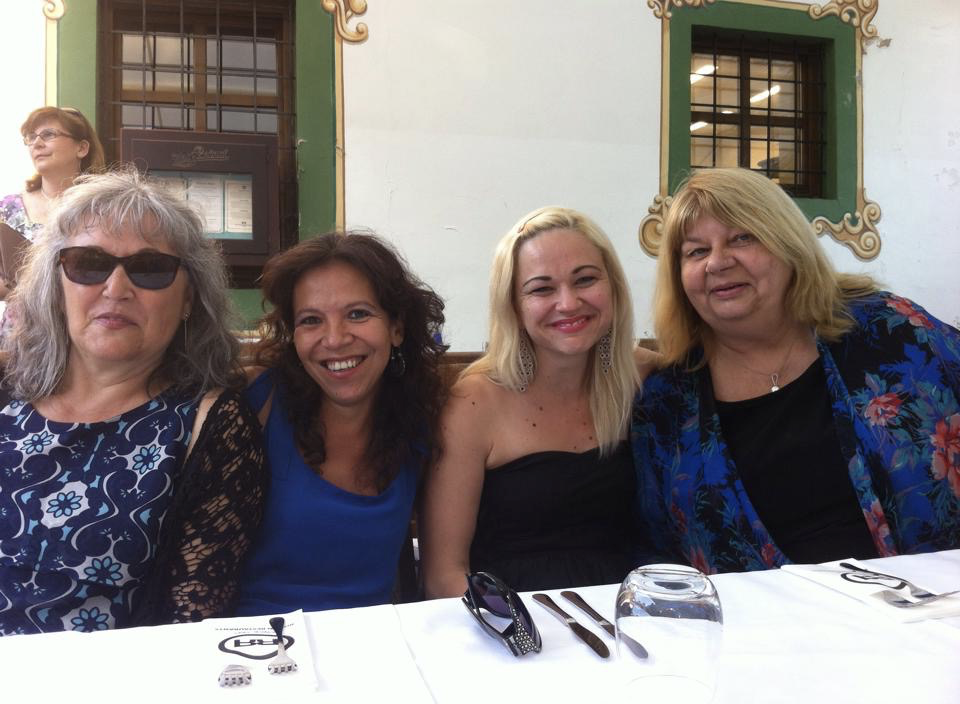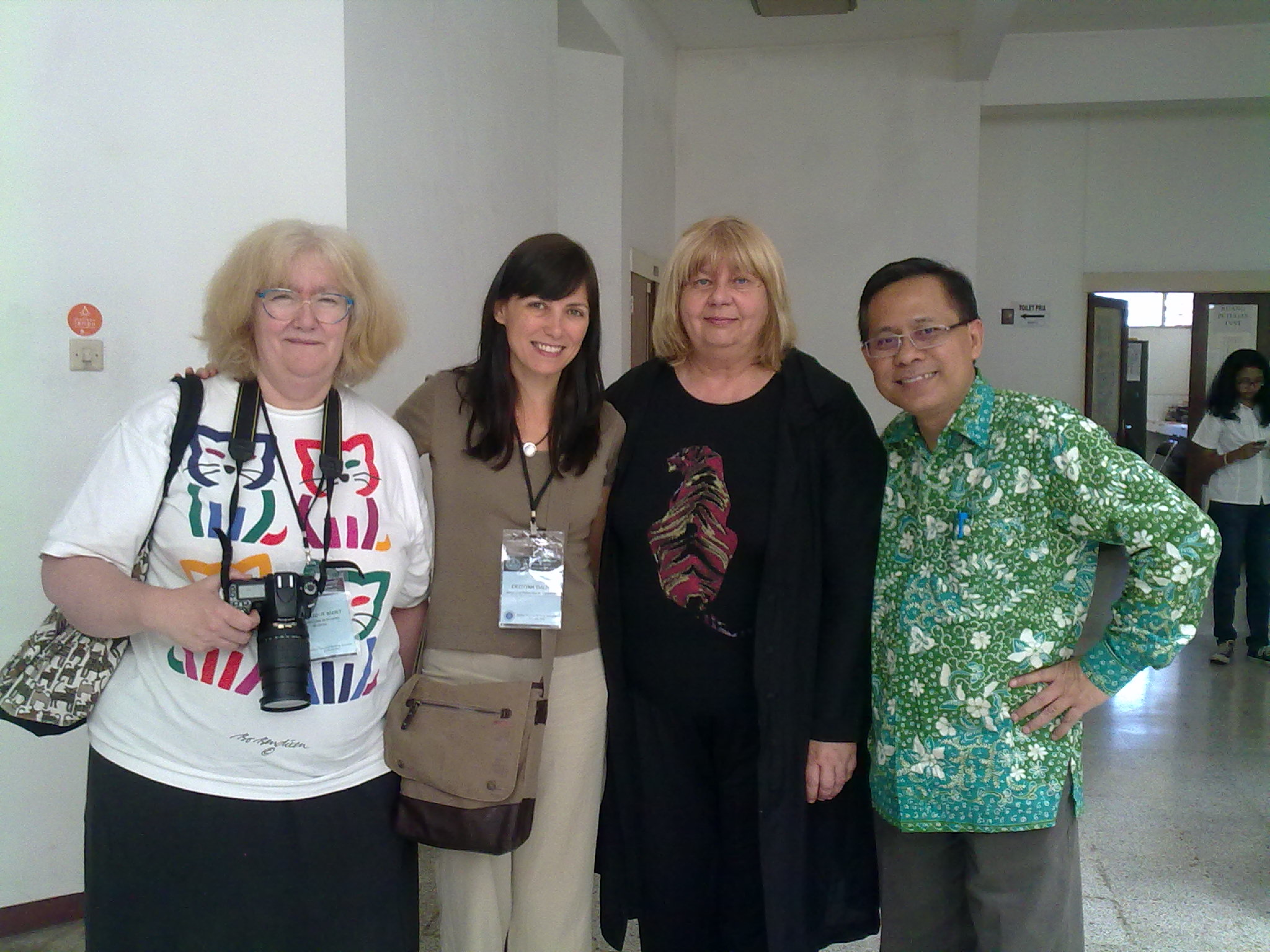Difference between revisions of "Mirka Miller's Combinatorics Webinar Series"
From Combinatorics Wiki
(→Talk 14: Measuring the closeness to Moore graphs - Prof. Nacho López) |
|||
| Line 14: | Line 14: | ||
'''Speaker: Prof. Diego González ''' | '''Speaker: Prof. Diego González ''' | ||
| − | '''Title:''' | + | '''Title: On mixed cages |
| − | + | ''' | |
| − | '''Abstract:''' | + | '''Abstract:''' A mixed graph is a graph with edges and arcs. A [z, r; g]-mixed cage is a mixed graph, z-regular by arcs, r-regular by edges with girth g and minimum order. In this talk I’m going to give an overview of the results in mixed cages, and I will talk about the monotonicity and the connectivity of mixed cages. This is a joint work with Gabriela Araujo and Claudia De la Cruz. |
---- | ---- | ||
Revision as of 07:17, 7 June 2022
Welcome to the home page for Mirka Miller's Combinatorics Webinar Series.
Meeting link: https://meet.google.com/kgc-uwpc-ngp
Contents
- 1 Upcoming Talks
- 2 Previous Talks
- 2.1 Talk 1: Celebrating Mirka's life - Prof. Camino Balbuena
- 2.2 Talk 2: May there be many more repeats - Prof. Jozef Širáň
- 2.3 Talk 3: The Domination Blocking Game - Prof. Dominique Buset
- 2.4 Talk 4: The story about graphs CD(k,q) - Prof. Felix Lazebnik
- 2.5 Talk 5: A Journey with Antimagic Labeling - Prof. Kiki Ariyanti Sugeng
- 2.6 Talk 6: Biregular Cages - Prof. Robert Jajcay
- 2.7 Talk 7: Open problema in Distance-based Graph Labelings - Prof. Rinovia Simanjuntak
- 2.8 Talk 8: On the existence of almost Moore digraphs - Prof. Edy Tri Baskoro
- 2.9 Talk 9: Strong cliques in diamond-free graphs - Prof. Berenice Martinez Barahona
- 2.10 Talk 10: Perfect Matchings in Regular Graph with Given Connectivity - Prof. Yuqing Lin
- 2.11 Talk 11: Colorings of Moore graphs - Prof. Mika Olsen
- 2.12 Talk 12: Four families of polynomials in spectral graph theory - Prof. Miquel Àngel Fiol
- 2.13 Talk 13: Berge’s conjecture for cubic graphs with small colouring defect - Prof. Edita Máčajová
- 2.14 Talk 14: Measuring the closeness to Moore graphs - Prof. Nacho López
- 3 Mirka's Research and related works
- 4 Photos
- 5 Organisers
Upcoming Talks
Date: Wednesday June 15 2022
Time: 17:00 (CET)
Speaker: Prof. Diego González
Title: On mixed cages Abstract: A mixed graph is a graph with edges and arcs. A [z, r; g]-mixed cage is a mixed graph, z-regular by arcs, r-regular by edges with girth g and minimum order. In this talk I’m going to give an overview of the results in mixed cages, and I will talk about the monotonicity and the connectivity of mixed cages. This is a joint work with Gabriela Araujo and Claudia De la Cruz.
Previous Talks
Talk 1: Celebrating Mirka's life - Prof. Camino Balbuena
Date: March 8 2021
Time 17:00 (CET)
Celebrating Mirka's life
Chair: Prof. Gabriela Araujo-Pardo
"Remembering Prof. Mirka Miller"
by Prof. Cristina Dalfó
Speaker: Prof. Camino Balbuena
Title: On the Moore cages with a prescribed girth pair
Abstract: https://drive.google.com/file/d/11r-TY8NswuKZkT7LOfkl-4yy1d72aF-w/view?usp=sharing
Slides: https://drive.google.com/file/d/1GkbwwNYSLBgRGjE8z7n1ckuXbXb6sRrN/view?usp=sharing
Video: https://drive.google.com/file/d/1DuWvsAsxMoIzCH4wr_hpGqUCx5uv89SU/view?usp=sharing {Chair: Prof. Gabriela Araujo-Pardo (minute 0:00-04:08) - "Remembering Prof. Mirka Miller" by Prof. Cristina Dalfó (minute 04:08-17:44) - Speaker: Prof. Camino Balbuena On the Moore cages with a prescribed girth pair (minute 17:44-end)}
Talk 2: May there be many more repeats - Prof. Jozef Širáň
Date: Wednesday April 14 2021
Time: 1000 Bratislava (0900 UK)
Speaker: Prof. Jozef Širáň
Title: May there be many more repeats
Abstract: This is my reminiscence on two mathematical aspects of my collaboration with Mirka Miller in the degree-diameter problem: the lifting technique in constructions of `large' examples and her method of repeats in non-existence proofs.
Video: https://drive.google.com/file/d/1Ss2xvDP9UAIebNUnIr2U6J01wixUJFkK/view?usp=sharing {Chair: Prof. Camino Balbuena (minute 0:00-02:26) - Speaker: Prof. Jozef Širáň May there be many more repeats (minute 02:26-end)}
Talk 3: The Domination Blocking Game - Prof. Dominique Buset
Date: Wednesday May 12 2021
Time: 11:00 (CET) - one hour later than the previous one
Speaker: Prof. Dominique Buset
Title: The Domination Blocking Game
Abstract: We introduce a new game on a simple, finite and undirected graph: “the domination tracking game”. Two players (the Dominator and the Enemy), each one playing alternatively, take a not occupied vertex on the graph. When the dominator (resp. the enemy) takes a vertex, he controls the vertex and all its neigbours (resp. just the vertex taken). The purpose of the game is for the dominator to control all the vertices, and for the enemy to avoid the dominator to win (i.e. to take one vertex and all his neighbours). We determine for some categories of graphs a winning strategy either for the Dominator or the Enemy. These situations, give a partition of those graphs into three classes. https://drive.google.com/file/d/1V8WY_qlqCDHdZLFsTokOQ-7t7KBtnqSG/view?usp=sharing
As part of the initiatives of Women in Mathematics Day
Video: https://drive.google.com/file/d/1HIv1fixjrWZfcRYHwN3QgntBKMoMK1Mt/view?usp=sharing
{Chair: Prof. Cristina Dalfó - Speaker: Prof. Dominique Buset The Domination Blocking Game }
Talk 4: The story about graphs CD(k,q) - Prof. Felix Lazebnik
Date: Wednesday June 16 2021
Time: 18:00 (CET)
Speaker: Prof. Felix Lazebnik
Title: The story about graphs CD(k,q)
Abstract: In this talk I will present the main ideas and history behind the construction of the family of graphs that is usually denoted by CD(k,q), where k is a positive integer, and q is a prime power. It is known that the girth of CD(k,q) (the length of its shortest cycle) is at least k+5, and these graphs provide the best known asymptotic lower bound for the greatest number of edges in graphs of a given order and given girth at least g, where g ≥ 5 and g distinct from 11, 12. We survey some old and new results, and mention several open questions related to these graphs or to similarly constructed graphs.
Slides: https://drive.google.com/file/d/13G9bVkwBEXgA6bkX4MJOgoAJsFRNorMs/view?usp=sharing
YouTube version of Cohen’s `Anthem’: https://youtu.be/c8-BT6y_wYg
Lev Arkad'evich Kaluznin (with M.H. Klin, G. Pöschel, V.I. Suschansky, V.A. Ustimenko, V.I. Vyshensky),
Applicandae Matematicae, 52:(1998) 5--18 MR 99m: 01091. https://drive.google.com/file/d/1Ak_MAzyE2FEW6kEflHi_1hDMghOiVp48/view?usp=sharing
General properties of some families of graphs defined by systems of equations. (joint work with A.J. Woldar),
Journal of Graph Theory, 38, (2001), 65--86. MR 2002k: 05108. https://drive.google.com/file/d/1vJCV9CXeOyfCoGp0Epmatw2n4BLu9be3/view?usp=sharing
Some Families of Graphs, Hypergraphs and Digraphs Defined by Systems of Equations: A Survey. (with Shuying Sun and Ye Wang),
Lecture Notes of Seminario Interdisciplinare di Matematica , Vol. 14 (2017), pp. 105–-142. https://drive.google.com/file/d/13HV9UrloLrxGt62_YOOJ-WT4cgDOZAiN/view?usp=sharing
Talk 5: A Journey with Antimagic Labeling - Prof. Kiki Ariyanti Sugeng
Date: Wednesday July 14 2021
Time: 15:00 (CEST)
Speaker: Prof. Kiki Ariyanti Sugeng
Title: A Journey with Antimagic Labeling
Abstract: Antimagic labeling is defined as an assignment from the element of a graph to usually a set of integers such that the weight of the element of the graph is all different. There are many variations of antimagic labeling, depending on which element of graph is labeled and how the weight is calculated. One of the definitions is as follows: A graph G is called antimagic if the edges can be labeled with the integers 1,2,...,q such that the sum of labels at any given vertex is different from the sum of the labels at any other vertex, i.e., no two vertices have the same sum. In this talk, I would like to share my journey with antimagic labeling through many variations of this labeling. https://drive.google.com/file/d/11AXXVAbNeJ9LbskDD_jZNoC9O2-XLHkP/view?usp=sharing
Slides: https://drive.google.com/file/d/1HGHz4e7pV6GJ1kICdbvVt8racCiMeZoN/view?usp=sharing
Video: https://drive.google.com/file/d/1YM18ibCuuB1XYH8A8XkK_S_I7yY_cCNg/view?usp=sharing
Talk 6: Biregular Cages - Prof. Robert Jajcay
Date: Wednesday September 15 2021
Time: 16:00 (CET)
Speaker: Prof. Robert Jajcay
Title: Biregular Cages
Abstract: The Cage Problem - the problem of finding a smallest k-regular graph of girth g, i.e., the (k,g)-cage - is well known to be very hard and the exact orders of cages are known for very few parameter pairs (k,g). One possible approach to understanding structural properties of cages includes considering biregular graphs that contain vertices of two degrees, m and n, and generalizing the Cage Problem by looking for smallest graphs of girth g containing vertices of the two degrees m and n, the (m,n;g)-cages. In the case of odd girths, results of this approach differ quite a bit from the regular Cage Problem as the orders of biregular (m,n;g)-cages are determined for all odd girths g and degree pairs m,n in which m is considerably smaller than n. The even girth case is still wide open, and has been therefore restricted to bipartite biregular graphs in which the two bipartite sets consist exclusively of vertices of one of the degrees (regular cages of even girth are also conjectured to be bipartite). We survey the most resent results on biregular and bipartite biregular cages, present some improved lower bounds, and discuss an interesting connection between bipartite biregular cages and t-designs.
Slides: https://drive.google.com/file/d/1GKlTVWu63BaPMhbEvPOibC8_CeQki3iK/view?usp=sharing
Video: https://drive.google.com/file/d/1cFV_jLyoge-NvFLGakkyxU-jhzWOq5s0/view?usp=sharing
Talk 7: Open problema in Distance-based Graph Labelings - Prof. Rinovia Simanjuntak
Date: Wednesday October 13 2021
Time: 13:00 (CET)
Speaker: Prof. Rinovia Simanjuntak
Title: Open problema in Distance-based Graph Labelings
Abstract: https://drive.google.com/file/d/1zLaEyrimiZphyQ-wWDMvi_SW8JS-uu59/view?usp=drivesdk
Slides: https://drive.google.com/file/d/1RW19I1fUWR0d7lHd13xQb1oHQbVVCYy6/view?usp=sharing
Video: https://drive.google.com/file/d/1FrUpH3vgGCOwzvTGuRnZ9uqH4CPSfbxF/view?usp=sharing
Talk 8: On the existence of almost Moore digraphs - Prof. Edy Tri Baskoro
Date: Wednesday November 10 2021
Time: 15:00 (CET)
Speaker: Prof. Edy Tri Baskoro
Title: On the existence of almost Moore digraphs
Abstract: https://drive.google.com/file/d/1L6t25SxIUEJAyt2z1F5jdLSFjgVbUfBv/view?usp=sharing
Video https://drive.google.com/file/d/1uDJtL9Anut5n2XT5fQA6PsXC1wOod-kH/view?usp=sharing
Talk 9: Strong cliques in diamond-free graphs - Prof. Berenice Martinez Barahona
Date: Wednesday December 15 2021
Time: 17:00 (CET)
Speaker: Prof. Berenice Martínez-Barona
Title: Strong cliques in diamond-free graphs
Abstract: A strong clique in a graph is a clique intersecting all inclusion-maximal stable sets. Strong cliques play an important role in the study of perfect graphs. In this talk, we study strong cliques in the class of diamond-free graphs, from both structural and algorithmic points of view. We show that the following five NP-hard or co-NP-hard problems all remain NP-hard or co-NP-hard when restricted to the class of diamond-free graphs: Is a given clique strong? Does the graph have a strong clique? Is every vertex contained in a strong clique? Given a partition of the vertex set into cliques, is every clique in the partition strong? Can the vertex set be partitioned into strong cliques?
On the positive side, we show that the following two problems whose computational complexity is open in general can be solved in linear time in the class of diamond-free graphs: Does every induced subgraph have a strong clique? Is every maximal clique strong? Is every edge contained in a strong clique? The last two results are derived from a characterization of diamond-free graphs in which every maximal clique is strong, which also implies an improved Erdös-Hajnal property for such graphs.
(Joint work with Nina Chiarelli, Martin Milanič, Jerome Monnot and Peter Muršič.)
Video https://drive.google.com/file/d/10rZ2fGwCdjR_uZvIqDuLIG5CXcTRdt1m/view?usp=sharing
Talk 10: Perfect Matchings in Regular Graph with Given Connectivity - Prof. Yuqing Lin
Date: Wednesday January 19 2022
Time: 9:30 Sydney time [23:30 (CET) of January 18th 2022]
Speaker: Prof. Yuqing Lin
Title: Perfect Matchings in Regular Graph with Given Connectivity
Abstract: The problem of how many edge disjoint perfect matchings are there in a graph is a classical topic in graph theory. Most of the work focus on the case where the degree is large, roughly speaking, equal to half of the total number of the vertices in the graph. For example, it has been conjectured that these graphs can be factorized. When working with this conjecture, we realize that the connectivity plays an important role in guarantee the graph has required number of perfect matchings and/or other factors. In this talk, I will present a few results we have obtained along this direction.
Video https://drive.google.com/file/d/1XIHFQKK8cPCccgEuNU8LEchtovKZfH7p/view?usp=sharing
Talk 11: Colorings of Moore graphs - Prof. Mika Olsen
Date: Wednesday February 16 2022
Time: 18:00 (CET)
Speaker: Prof. Mika Olsen - Universidad Autónoma Metropolitana- Cuajimalpa (UAM-Cuajimalpa), México
Title: Colorings of Moore graphs
Abstract: Coloring graphs is a popular topic in graph theory. In this talk I consider two different colorings of Moore graphs, namely rainbow colorings of edges and packing colorings of vertices.
A path P in an edge-colored graph is a rainbow path if there are no arcs of P with the same color. The rainbow connectivity rc(G) is the smallest integer k such that there is an edge coloring of a graph satisfying that the graph is connected by rainbow paths.
A vertex coloring of a graph is a packing coloring if any pair of vertices of color i satisfies that the distance between them is at least i+1. The packing chromatic number is the is the smallest integer k such that there is a packing coloring with k colors.
I will present results for the rainbow t-connectivity of (k,6)-Moore graphs and results for packing chromatic number of Moore graphs with girth 6,8 and 12. In both cases the results where obtained using structures of Moore graphs.
Video https://drive.google.com/file/d/13kyGioVoVGcKliUAt_0afyEJmgdtBiZK/view?usp=sharing
Talk 12: Four families of polynomials in spectral graph theory - Prof. Miquel Àngel Fiol
Date: Wednesday March 16 2022
Time: 17:00 (CET)
Speaker: Prof. Miquel Àngel Fiol
Title: Four families of polynomials in spectral graph theory
Abstract: In this talk, we describe four families of polynomials related to the spectrum of a graph. First, some known main results involving such polynomials, such as the spectral excess theorem characterizing distance-regularity, are discussed. Second, some new results giving bounds for the k-independence number αk of a graph are presented. In this context, we comment on some relationships between the inertia (Cvetkovic) and ratio (Hoffman) bounds of αk.
Slides: [https://drive.google.com/file/d/1EbfdMPDFXfs1E8CtUbCBtrSw7mT-gE2f/view?usp=sharing https://drive.google.com/file/d/1EbfdMPDFXfs1E8CtUbCBtrSw7mT-gE2f/view?usp=sharing]
Video: [https://drive.google.com/file/d/1MyQ-SsQ5bXVc4nUYmyjxGCSwVaH3iNQo/view?usp=sharing https://drive.google.com/file/d/1MyQ-SsQ5bXVc4nUYmyjxGCSwVaH3iNQo/view?usp=sharing]
Talk 13: Berge’s conjecture for cubic graphs with small colouring defect - Prof. Edita Máčajová
Date: Wednesday April 20 2022
Time: TBA
Speaker: Prof. Edita Máčajová
Title: Berge’s conjecture for cubic graphs with small colouring defect
Abstract: https://drive.google.com/file/d/1tAEybLG2Pg1G6DYQSaTW14y1HOqteIFa/view?usp=sharing
Video: https://drive.google.com/file/d/1kgAmb7zQB9Jvsrr4y8Lt0pgK1JB4z-L6/view?usp=sharing
Talk 14: Measuring the closeness to Moore graphs - Prof. Nacho López
Date: Wednesday May 18 2022
Time: 15:00 (CET)
Speaker: Prof. Nacho López
Title: Measuring the closeness to Moore graphs
Abstract: In this talk we will discuss how to measure the closeness to a Moore graph. This `closeness' has been usually measured as the difference between the (unattainable) Moore bound and the order of the considered graphs. Another kind of approach considers relaxing some of the constraints implied by the Moore bound. For instance, we could relax the condition of the degree and admit few vertices with larger degree, as Mirka did for the directed case. Radial Moore graphs are also approximations of Moore graphs, where we allow the existence of vertices with eccentricity just on more than the value they have in a Moore graph. Once we have many different graphs close to Moore graph, an interesting question is how to rank them according to their proximity to being a Moore graph.
Slides: https://drive.google.com/file/d/1FeqbpnXDWpS7xd37Zknyh3ZQ15H0JR38/view?usp=sharing
Video: https://drive.google.com/file/d/1C7zLSb3b_anh3oXE2MZz0BpoPXVOZN_6/view?usp=sharing
Obituaries: Mirka Miller (nee Koutova) https://drive.google.com/file/d/1su6y1qhUkR3PosqRDfFSGhFbKz1oseP1/view?usp=sharing
Special Issue in Honour of Mirka Miller https://drive.google.com/file/d/1wWRIXelvnGhkOM7IlhZhH0G0xxT6rd0s/view?usp=sharing
In memoriam Emeritus Professor Mirka Miller https://drive.google.com/file/d/1WQVHk41Yi5fJuGhWYscN9CwwirdU8uOu/view?usp=sharing
Eulogy for Professor Mirka Miller (1949–2016) [v https://drive.google.com/file/d/1hTS8HxU9omjlF2Q-_jOQIREcguR1Y1FU/view?usp=sharing]
A family of mixed graphs with large order and diameter 2 https://drive.google.com/file/d/1zbwb56QKY1iSeOm6c4ko178Y0UXNIzfL/view?usp=sharing
Photos
Organisers
• Marién Abreu - Dipartimento di Matematica, Informatica ed Economia - Università degli Studi della Basilicata - Potenza, Italia
• Gabriela Araujo-Pardo - Mathematics Institute-Juriquilla - Universidad Nacional Autónoma de México, México
• Camino Balbuena - Department of Civil and Enviromental Engineering - Universitat Politècnica de Catalunya, Spain
• Cristina Dalfó - Cryptography and Graphs Research Group - Universitat de Lleida, Igualada (Barcelona), Catalonia
• Tatiana Jajcayova - Faculty of Mathematics, Physics and Informatics - Comenius University, Bratislava, Slovakia
Honorary Organiser
• Joe Ryan - School of Electrical Engineering and Computing - University of Newcastle, Australia
Website Host and Support
• Grahame Erskine - Department of Mathematics of Statistics - The Open University, UK.
(the organisers thank him for kindly including this website in Combinatorics Wiki)





